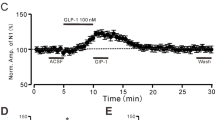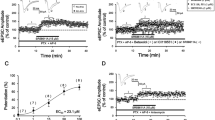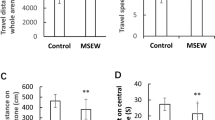Abstract
Allopregnanolone is one of the most important neurosteroids in the brain. We studied the effect and mechanism of allopregnanolone on spontaneous and evoked glutamate release in the medial prefrontal cortex using electrophysiological and biochemical methods combined with pharmacological approaches. The results showed that allopregnanolone had no effects on the frequency of miniature excitatory postsynaptic current (mEPSCs), but inhibited the depolarizing agent veratridine-evoked increase in the frequency of spontaneous excitatory postsynaptic currents (sEPSCs) and inhibited the first of the two responses evoked by a pair of electrical pulses more effectively than the second, resulting in increased paired-pulse facilitation (PPF) and thus suggesting a presynaptic inhibitory effect on electrical pulse-evoked glutamate release. A similar effect was also obtained for the effect of allopregnanolone on protein kinase A (PKA) activation, an upstream event of presynaptic glutamate release. Interestingly, allopregnanolone had none of these effects in the striatum. In the study of the upstream mechanism of the PKA inhibition by allopregnanolone, we found that allopregnanolone inhibited extracellular calcium influx-evoked PKA activation, but had no effects on intracellular calcium store release-evoked PKA activation; L-type calcium channel antagonists, but not N- and P/Q-type calcium channel antagonist, blocked the effect of allopregnanolone; allopregnanolone inhibited L-type calcium channel agonist-evoked increase in the PKA activity, intrasynaptosomal calcium concentration and frequency of sEPSCs. These results suggest that allopregnanolone inhibits evoked glutamate release via the inhibition of L-type calcium channels in the medial prefrontal cortex, but does not in the striatum.
Similar content being viewed by others
Log in or create a free account to read this content
Gain free access to this article, as well as selected content from this journal and more on nature.com
or
References
Adams B, Moghaddam B (1998). Corticolimbic dopamine neurotransmission is temporally dissociated from the cognitive and locomotor effects of phencyclidine. J Neurosci 18: 5545–5554.
Barbaccia ML, Affricano D, Purdy RH, Maciocco E, Spiga F, Biggio G (2001). Clozapine, but not haloperidol, increases brain concentrations of neuroactive steroids in the rat. Neuropsychopharmacology 25: 489–497.
Bargas J, Ayala GX, Hernandez E, Galarraga E (1998). Ca2+-channels involved in neostriatal glutamatergic transmission. Brain Res Bull 45: 521–524.
Bouron A, Reuter H (1999). The D1 dopamine receptor agonist SKF-38393 stimulates the release of glutamate in the hippocampus. Neuroscience 94: 1063–1070.
Castner SA, Goldman-Rakic PS, Williams GV (2004). Animal models of working memory: insights for targeting cognitive dysfunction in schizophrenia. Psychopharmacology (Berlin) 174: 111–125.
Clark KA, Randall AD, Collingridge GL (1994). A comparison of paired-pulsed facilitation of AMPA and NMDA receptor-mediated excitatory postsynaptic currents in the hippocampus. Exp Brain Res 101: 272–278.
Creager R, Dunwiddie T, Lynch G (1980). Paired-pulse and frequency facilitation in the CA1 region of the in vitro rat hippocampus. J Physiol 299: 409–424.
Dunlap K, Luebke JI, Turner TJ (1995). Exocytotic Ca2+ channels in mammalian central neurons. Trends Neurosci 18: 89–98.
Evans DI, Jones RS, Woodhall G (2000). Activation of presynaptic group III metabotropic receptors enhances glutamate release in rat entorhinal cortex. J Neurophysiol 83: 2519–2525.
Garcia-Sanz A, Badia A, Clos MV (2001). Superfusion of synaptosomes to study presynaptic mechanisms involved in neurotransmitter release from rat brain. Brain Res Protoc 7: 94–102.
Grilli M, Raiteri L, Pittaluga A (2004). Somatostatin inhibits glutamate release from mouse cerebrocortical nerve endings through presynaptic sst2 receptors linked to the adenylyl cyclase-protein kinase A pathway. Neuropharmacology 46: 388–396.
Grynkiewicz G, Poenie M, Tsien RY (1985). A new generation of Ca2+ indicators with greatly improved fluorescence properties. J Biol Chem 260: 3440–3450.
Harrison SM, Jarvie PE, Dunkley PR (1988). A rapid Percoll gradient procedure for isolation of synaptosomes directly from an S1 fraction: viability of subcellular fractions. Brain Res 441: 72–80.
Hempel CM, Hartman KH, Wang XJ, Turrigiano GG, Nelson SB (2000). Multiple forms of short-term plasticity at excitatory synapses in rat medial prefrontal cortex. J Neurophysiol 83: 3031–3041.
Ishikawa A, Nakamura S (2003). Convergence and interaction of hippocampal and amygdalar projections within the prefrontal cortex in the rat. J Neurosci 23: 9987–9995.
Iyadomi M, Iyadomi I, Kumamoto E, Tomokuni K, Yoshimura M (2000). Presynaptic inhibition by baclofen of miniature EPSCs and IPSCs in substantia gelatinosa neurons of the adult rat spinal dorsal horn. Pain 85: 385–393.
Khisti RT, Deshpande LS, Chopde CT (2002). The neurosteroid 3 alpha-hydroxy-5 alpha-pregnan-20-one affects dopamine-mediated behavior in rodents. Psychopharmacology (Berlin) 161: 120–128.
Khisti RT, Mandhane SN, Chopde CT (1998). The neurosteroid 3 alpha-hydroxy-5 alpha-pregnan-20-one induces catalepsy in mice. Neurosci Lett 251: 85–88.
Leenders AG, Sheng ZH (2005). Modulation of neurotransmitter release by the second messenger-activated protein kinases: implications for presynaptic plasticity. Pharmacol Ther 105: 69–84.
Leskiewicz M, Budziszewska B, Jaworska-Feil L, Kajta M, Lason W (1998). Effect of neurosteroids on glutamate binding sites and glutamate uptake in rat hippocampus. Pol J Pharmacol 50: 355–360.
Li Y, Bennett DJ (2003). Persistent sodium and calcium currents cause plateau potentials in motoneurons of chronic spinal rats. J Neurophysiol 90: 857–869.
Lingamaneni R, Hemmings Jr HC (1999). Effects of anticonvulsants on veratridine- and KCl-evoked glutamate release from rat cortical synaptosomes. Neurosci Lett 276: 127–130.
Lipscombe D, Helton TD, Xu W (2004). L-type calcium channels: the low down. J Neurophysiol 92: 2633–2641.
Lopez E, Oset-Gasque MJ, Figueroa S, Albarran JJ, Gonzalez MP (2001). Calcium channel types involved in intrinsic amino acid neurotransmitters release evoked by depolarizing agents in cortical neurons. Neurochem Int 39: 283–290.
Lou LG, Pei G (1997). Modulation of protein kinase C and cAMP-dependent protein kinase by delta-opioid. Biochem Biophys Res Commun 236: 626–629.
Lovinger DM, Merritt A, Reyes D (1994). Involvement of N- and non-N-type calcium channels in synaptic transmission at corticostriatal synapses. Neuroscience 62: 31–40.
Majewska MD, Harrison NL, Schwartz RD, Barker JL, Paul SM (1986). Steroid hormone metabolites are barbiturate-like modulators of the GABA receptor. Science 232: 1004–1007.
Mamczarz J, Budziszewska B, ntkiewicz-Michaluk L, Vetulani J (1999). The Ca2+ channel blockade changes the behavioral and biochemical effects of immobilization stress. Neuropsychopharmacology 20: 248–254.
Mamczarz J, Karolewicz B, ntkiewicz-Michaluk L, Vetulani J (1994). Co-administration of nifedipine with neuroleptics prevents development of activity changes during withdrawal. Pol J Pharmacol 46: 75–77.
Martin ED, Buno W (2003). Caffeine-mediated presynaptic long-term potentiation in hippocampal CA1 pyramidal neurons. J Neurophysiol 89: 3029–3038.
Marx CE, Duncan GE, Gilmore JH, Lieberman JA, Morrow AL (2000). Olanzapine increases allopregnanolone in the rat cerebral cortex. Biol Psychiatry 47: 1000–1004.
Marx CE, VanDoren MJ, Duncan GE, Lieberman JA, Morrow AL (2003). Olanzapine and clozapine increase the GABAergic neuroactive steroid allopregnanolone in rodents. Neuropsychopharmacology 28: 1–13.
Meissner G (1986). Ryanodine activation and inhibition of the Ca2+ release channel of sarcoplasmic reticulum. J Biol Chem 261: 6300–6306.
Millan C, Torres M, Sanchez-Prieto J (2003). Co-activation of PKA and PKC in cerebrocortical nerve terminals synergistically facilitates glutamate release. J Neurochem 87: 1101–1111.
Minta A, Kao JP, Tsien RY (1989). Fluorescent indicators for cytosolic calcium based on rhodamine and fluorescein chromophores. J Biol Chem 264: 8171–8178.
Moghaddam B, Adams B, Verma A, Daly D (1997). Activation of glutamatergic neurotransmission by ketamine: a novel step in the pathway from NMDA receptor blockade to dopaminergic and cognitive disruptions associated with the prefrontal cortex. J Neurosci 17: 2921–2927.
Moghaddam B, Adams BW (1998). Reversal of phencyclidine effects by a group II metabotropic glutamate receptor agonist in rats. Science 281: 1349–1352.
Nelson CL, Burk JA, Bruno JP, Sarter M (2002). Effects of acute and repeated systemic administration of ketamine on prefrontal acetylcholine release and sustained attention performance in rats. Psychopharmacology (Berlin) 161: 168–179.
Nichols RA, Mollard P (1996). Direct observation of serotonin 5-HT3 receptor-induced increases in calcium levels in individual brain nerve terminals. J Neurochem 67: 581–592.
Nichols RA, Suplick GR, Brown JM (1994). Calcineurin-mediated protein dephosphorylation in brain nerve terminals regulates the release of glutamate. J Biol Chem 269: 23817–23823.
ntkiewicz-Michaluk L (1999). Voltage-operated calcium channels: characteristics and their role in the mechanism of action of psychotropic drugs. Pol J Pharmacol 51: 179–186.
ntkiewicz-Michaluk L, Karolewicz B, Michaluk J, Vetulani J (1995). Differences between haloperidol- and pimozide-induced withdrawal syndrome: a role for Ca2+ channels. Eur J Pharmacol 294: 459–467.
ntkiewicz-Michaluk L, Michaluk J, Romanska I, Vetulani J (1990). Effect of repetitive electroconvulsive treatment on sensitivity to pain and on [3H]nitrendipine binding sites in cortical and hippocampal membranes. Psychopharmacology (Berlin) 101: 240–243.
ntkiewicz-Michaluk L, Michaluk J, Romanska I, Vetulani J (1993). Reduction of morphine dependence and potentiation of analgesia by chronic co-administration of nifedipine. Psychopharmacology (Berlin) 111: 457–464.
ntkiewicz-Michaluk L, Michaluk J, Romanska I, Vetulani J (1994a). Differential involvement of voltage-dependent calcium channels in apomorphine-induced hypermotility and stereotypy. Psychopharmacology (Berlin) 113: 555–560.
ntkiewicz-Michaluk L, Michaluk J, Vetulani J (1994b). Modification of effects of chronic electroconvulsive shock by voltage-dependent Ca2+ channel blockade with nifedipine. Eur J Pharmacol 254: 9–16.
ntkiewicz-Michaluk L, Romanska I, Vetulani J (1997). Ca2+ channel blockade prevents lysergic acid diethylamide-induced changes in dopamine and serotonin metabolism. Eur J Pharmacol 332: 9–14.
Puia G, Mienville JM, Matsumoto K, Takahata H, Watanabe H, Costa E et al (2003). On the putative physiological role of allopregnanolone on GABA(A) receptor function. Neuropharmacology 44: 49–55.
Reuter H (1996). Diversity and function of presynaptic calcium channels in the brain. Curr Opin Neurobiol 6: 331–337.
Sabria J, Pastor C, Clos MV, Garcia A, Badia A (1995). Involvement of different types of voltage-sensitive calcium channels in the presynaptic regulation of noradrenaline release in rat brain cortex and hippocampus. J Neurochem 64: 2567–2571.
Schoppa NE, Westbrook GL (1997). Modulation of mEPSCs in olfactory bulb mitral cells by metabotropic glutamate receptors. J Neurophysiol 78: 1468–1475.
Seamans JK, Floresco SB, Phillips AG (1995). Functional differences between the prelimbic and anterior cingulate regions of the rat prefrontal cortex. Behav Neurosci 109: 1063–1073.
Sitges M, Galindo CA (2005). Omega-agatoxin-TK is a useful tool to study P-type Ca2+ channel-mediated changes in internal Ca2+ and glutamate release in depolarised brain nerve terminals. Neurochem Int 46: 53–60.
Tauboll E, Ottersen OP, Gjerstad L (1993). The progesterone metabolite 5 alpha-pregnan-3 alpha-ol-20-one reduces K(+)-induced GABA and glutamate release from identified nerve terminals in rat hippocampus: a semiquantitative immunocytochemical study. Brain Res 623: 329–333.
Ulbricht W (1969). The effect of veratridine on excitable membranes of nerve and muscle. Ergeb Physiol 61: 18–71.
Wang Z, Zheng P (2001). Characterization of spontaneous excitatory synaptic currents in pyramidal cells of rat prelimbic cortex. Brain Res 901: 303–313.
Wilson MA, Biscardi R (1997). Influence of gender and brain region on neurosteroid modulation of GABA responses in rats. Life Sci 60: 1679–1691.
Wiser O, Trus M, Hernandez A, Renstrom E, Barg S, Rorsman P et al (1999). The voltage sensitive Lc-type Ca2+ channel is functionally coupled to the exocytotic machinery. Proc Natl Acad Sci USA 96: 248–253.
Zucker RS (1973). Changes in the statistics of transmitter release during facilitation. J Physiol 229: 787–810.
Acknowledgements
This work was supported by Project 39970241 and 30670653 of National Natural Science and Foundation of China, by Trans–Century Training Program Foundation for the Talents by the State Education Commission and by Project 04DZ14005 of Shanghai Science and Technology Committee.
Author information
Authors and Affiliations
Corresponding author
Rights and permissions
About this article
Cite this article
Hu, AQ., Wang, ZM., Lan, DM. et al. Inhibition of Evoked Glutamate Release by Neurosteroid Allopregnanolone Via Inhibition of L-Type Calcium Channels in Rat Medial Prefrontal Cortex. Neuropsychopharmacol 32, 1477–1489 (2007). https://doi.org/10.1038/sj.npp.1301261
Received:
Revised:
Accepted:
Published:
Issue date:
DOI: https://doi.org/10.1038/sj.npp.1301261



